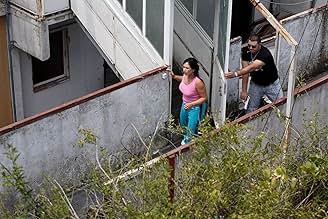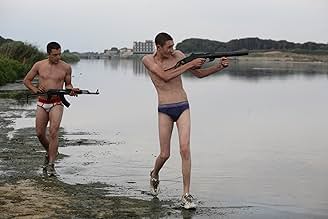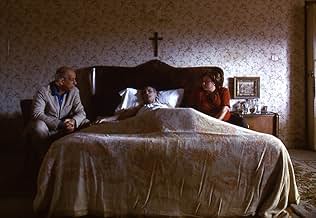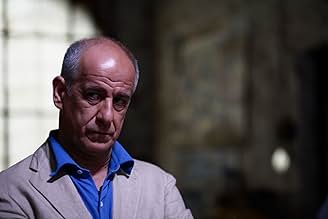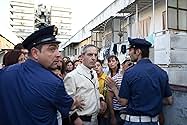VALUTAZIONE IMDb
7,0/10
52.503
LA TUA VALUTAZIONE
Uno sguardo dall'interno sulle famiglie criminali moderne in Italia.Uno sguardo dall'interno sulle famiglie criminali moderne in Italia.Uno sguardo dall'interno sulle famiglie criminali moderne in Italia.
- Regia
- Sceneggiatura
- Star
- Nominato ai 1 BAFTA Award
- 34 vittorie e 42 candidature totali
Salvatore Abbruzzese
- Totò
- (as Salvatore Abruzzese)
Vincenzo Altamura
- Gaetano
- (as Gaetano Altamura)
Recensioni in evidenza
When most people think of the mafia they think of American mobsters or Sicilians; this film tells of a group even more dangerous... The Camorra on Naples. Rather than having a conventional narrative we get glimpses into the lives of various people connected to crime in the city. Marco and Ciro; a pair of wannabe gangsters who operate independently and think they've hit the big time when they find a Camorra weapons stash; Don Ciro, a timid middleman who delivers payments to the families of gaoled gang members; Pasquale, a tailor who works at a factory controlled by the mob and Totò a thirteen year old grocery delivery boy who gradually gets caught up in the crime, amongst others. We see who the Camorra has its tentacles everywhere; drugs, weapons, fake designer goods and illegal disposal of toxic waste. The crime is profitable and the various subgroups are more than willing to kill to keep control of what they have already or to take what they want from others.
This film is far from being a feel good story; it never glamorises the criminal lifestyle but instead shows how it ruins the lives of those it touches like a cancer eating away at the society. Nobody here is seen living the high life. The way it is filmed with hand held cameras on real locations give the film an almost documentary feel; as though we are there with real gangsters not seeing people act. The actors all do a good job at making their various characters seem real. There are plenty of shocking moments even when one has been primed to expect something bad to happen. Perhaps the biggest shock is that all of this is happening in a modern European country not somewhere less developed. Overall I'd definitely recommend this to people interested in the subject; just don't expect any laughs or thrills... the violence is sudden and brutal not exciting.
These comments are based on watching the film in Italian with English subtitles.
This film is far from being a feel good story; it never glamorises the criminal lifestyle but instead shows how it ruins the lives of those it touches like a cancer eating away at the society. Nobody here is seen living the high life. The way it is filmed with hand held cameras on real locations give the film an almost documentary feel; as though we are there with real gangsters not seeing people act. The actors all do a good job at making their various characters seem real. There are plenty of shocking moments even when one has been primed to expect something bad to happen. Perhaps the biggest shock is that all of this is happening in a modern European country not somewhere less developed. Overall I'd definitely recommend this to people interested in the subject; just don't expect any laughs or thrills... the violence is sudden and brutal not exciting.
These comments are based on watching the film in Italian with English subtitles.
A realistic film about the Neapolitan Mafia, The movie has a documentary touch which i really liked the most, the ending is perfect and real.
A must-see!
Garners more respect than a spot on favorites list, "Gomorra" chronicles five seemingly disconnected stories with one thing in common: all are heavily influenced by a criminal organization run by the Camorras, an ominous mafia organization with a tight grip on Naples, Italy. Stylishly delivered, with extra kudos on editing and cinematography, Film will no doubt attract fans of the violent underworld, but might be disappointed by its verite approach, even if it perfectly captures reality, as such. Absolute antithesis to depiction from the American mafia, film is gritty and has zero entertainment value but in retrospect, picture was produced with such depressing intentions.
Multi plot film features more on characters attracted by the allure of the Camorras than the Camorras themselves. The five stories were plucked out from a novel by Roberto Saviano: the non-fiction that thrived on the best seller's list in Italy. Stories range from a coming of age teenager wanting to be identified with the mafia to a fresh university graduate looking for a promising vocation. Through varying levels of perspectives: from the violent eyed to the diplomatic, "Gomorra" stuns as it lists the organization's almost totalitarian control over the underbelly of Italy. It creates the impression of a country rotting from the inside out. With each story written by a different writer, what could have been an interconnection disaster is controlled well by director Matteo Garrone.
Ambitiously edited, fine balance between chaos and narrative is clearly defined by Marco Spoletini. First 40 minutes won't bode well for viewers looking for an easy diversion, as it is edited to confusion creating the illusion that the film started midway. Nonetheless, the stories do emerge, to great relief and from there on out, film would have established its style to a keen audience.
Cinematography, too is top notch. Marco Onorato paints Italy with a dull set of colors, resembling more of a third world purgatory rather than a honeymooner's travel brochure. Even Venice's bright reds and blues are muted with grey and brown with a hint of overexposure. Overall effect adds stupendously to the film as it gives it a sense of space and absolutely squashes any sense of hope an over-reader might derive.
Accuracy is greatly appreciated here. Film tries to blurry lines between dramatic film and documentary with impressive results. Details are all intact: dialogue is accurately more dialect derived, shooting locations seem extracted from a news clip and most thesping is done on dead-on accuracy by first timers.
With production values on stratospheric levels, film's overall intention is transparent: absolutely naught empathy is allowed, allowing audiences to soak in the moody atmosphere and simply co-exist with the protagonists clearly tested by circumstance. This will be its main predicament in garnering a more universal success as it asks a lot from an audience whose expectations might lean towards the slick of "Cidade de Deus".
With everything into consideration, film is too well choreographed that it becomes as intimidating as the organization that it exposes. Multiple plays won't be troublesome as every single detail here has a sense of subtext of tragedy unwilling to be diluted by repetition. However, might only be uncovered by fans willing to revisit.
Picture won the Grand Prize of the 2008 Cannes Film Festival.
Multi plot film features more on characters attracted by the allure of the Camorras than the Camorras themselves. The five stories were plucked out from a novel by Roberto Saviano: the non-fiction that thrived on the best seller's list in Italy. Stories range from a coming of age teenager wanting to be identified with the mafia to a fresh university graduate looking for a promising vocation. Through varying levels of perspectives: from the violent eyed to the diplomatic, "Gomorra" stuns as it lists the organization's almost totalitarian control over the underbelly of Italy. It creates the impression of a country rotting from the inside out. With each story written by a different writer, what could have been an interconnection disaster is controlled well by director Matteo Garrone.
Ambitiously edited, fine balance between chaos and narrative is clearly defined by Marco Spoletini. First 40 minutes won't bode well for viewers looking for an easy diversion, as it is edited to confusion creating the illusion that the film started midway. Nonetheless, the stories do emerge, to great relief and from there on out, film would have established its style to a keen audience.
Cinematography, too is top notch. Marco Onorato paints Italy with a dull set of colors, resembling more of a third world purgatory rather than a honeymooner's travel brochure. Even Venice's bright reds and blues are muted with grey and brown with a hint of overexposure. Overall effect adds stupendously to the film as it gives it a sense of space and absolutely squashes any sense of hope an over-reader might derive.
Accuracy is greatly appreciated here. Film tries to blurry lines between dramatic film and documentary with impressive results. Details are all intact: dialogue is accurately more dialect derived, shooting locations seem extracted from a news clip and most thesping is done on dead-on accuracy by first timers.
With production values on stratospheric levels, film's overall intention is transparent: absolutely naught empathy is allowed, allowing audiences to soak in the moody atmosphere and simply co-exist with the protagonists clearly tested by circumstance. This will be its main predicament in garnering a more universal success as it asks a lot from an audience whose expectations might lean towards the slick of "Cidade de Deus".
With everything into consideration, film is too well choreographed that it becomes as intimidating as the organization that it exposes. Multiple plays won't be troublesome as every single detail here has a sense of subtext of tragedy unwilling to be diluted by repetition. However, might only be uncovered by fans willing to revisit.
Picture won the Grand Prize of the 2008 Cannes Film Festival.
In 2003, Giancarlo De Cataldo, a judge-turned-novelist, wrote Romanzo Criminale (Crime Novel in English), a largely truthful recollection (only the names were changed) of the Magliana gang, a Roman crime organization he had sentenced to prison. Three years later, Neapolitan journalist Roberto Saviano wrote Gomorra, a first-hand, non-fiction analysis of how organized crime controls everything in his native region. The book was the result of months of direct contact with the people who keep the System (the gangsters themselves refuse to use the word Camorra, which can be considered the local version of the Sicilian Mafia) and became a huge success, the downside of which was Saviano receiving multiple death threats from the people he'd exposed and being forced to live with a permanent police escort. The reason I'm mentioning both books is they were both made into successful films (Gomorra even walked away with the Grand Prize of the Jury at the 2008 Cannes Film Festival), with one crucial difference: Romanzo Criminale is very good, but does at times, as implied by the title, feel like a novel, a fictional story. Gomorra, on the other hand, using the same raw, in-your-face style as City of God, throws the viewer into a new, scary world - the real deal.
Director Matteo Garrone, who co-wrote the screenplay with a bunch of collaborators (including Saviano himself), wisely decides to ditch the book's first-person storytelling, the only (possible) reference to the author being a young man named Roberto who helps businessman Franco (Toni Servillo) close a series of suspicious deals with various companies in the North of Italy (Venice is explicitly shown). Franco's line of work, which will sound amusing to anyone who's watched The Sopranos, is waste management, though not of the legal kind. His story is one of five that constitute the film's narrative: along with him, there's also Don Ciro (Gianfelice Imparato), who pays the family members of imprisoned crooks; Pasquale (Salvatore Cantalupo), a tailor whose life is at risk because of his contacts with the Chinese (Italians don't like competition) and whose work ends up being worn by celebrities like Scarlett Johansson (Angelina Jolie in the book); and then there are two different examples of young blood, one a loyal boy who runs errands for his drug-dealing neighbors, the other two young punks who have watched Scarface way too often (a reference to the fact that a real-life Camorra boss had his villa designed exactly like Tony Montana's) and think they can take over.
An ensemble gangster flick, then. Not quite: this is no Altman movie, which means the separate plot strands never once cross paths. This is because Gomorra doesn't set out to be a real, straightforward story, but rather offer a series of bleak, extremely real examples of how the Camorra (or the System, though neither word is ever spoken in the film) controls everything. Aside from the documentary-style cinematography and anxious cutting, the highest degree of realism comes from the cast: the only really famous actor in the film is Servillo, familiar from Paolo Sorrentino's filmography; the rest have a theatrical background or, in the case of the kids especially, were taken directly from the street (the movie was shot on location, and rumor has it the mother of a Camorra boss asked for a cameo). This shows most clearly in the way they speak: with few exceptions (Franco most notably), the characters' Neapolitan dialect is so strong the film had to be subtitled in most parts of Italy. Garrone and Saviano's message is clear: this isn't your usual genre flick, it's something else - something palpable, something real, something terrifying.
Gomorra's top achievement is that it doesn't play to the stereotype of Italy being nothing but the home of gangsters. On the contrary, it pinpoints a sad fact, its intent being to denounce and make aware, never to glorify. Sure, it opens with a shootout that could remind of Goodfellas (still one of the best first-hand crime tales) or The Sopranos, but even those masterpieces are too smooth and polished next to the gritty, unsettling universe that emerges from this film. It's dirty, brutal, scary. And it simply has to be seen.
Director Matteo Garrone, who co-wrote the screenplay with a bunch of collaborators (including Saviano himself), wisely decides to ditch the book's first-person storytelling, the only (possible) reference to the author being a young man named Roberto who helps businessman Franco (Toni Servillo) close a series of suspicious deals with various companies in the North of Italy (Venice is explicitly shown). Franco's line of work, which will sound amusing to anyone who's watched The Sopranos, is waste management, though not of the legal kind. His story is one of five that constitute the film's narrative: along with him, there's also Don Ciro (Gianfelice Imparato), who pays the family members of imprisoned crooks; Pasquale (Salvatore Cantalupo), a tailor whose life is at risk because of his contacts with the Chinese (Italians don't like competition) and whose work ends up being worn by celebrities like Scarlett Johansson (Angelina Jolie in the book); and then there are two different examples of young blood, one a loyal boy who runs errands for his drug-dealing neighbors, the other two young punks who have watched Scarface way too often (a reference to the fact that a real-life Camorra boss had his villa designed exactly like Tony Montana's) and think they can take over.
An ensemble gangster flick, then. Not quite: this is no Altman movie, which means the separate plot strands never once cross paths. This is because Gomorra doesn't set out to be a real, straightforward story, but rather offer a series of bleak, extremely real examples of how the Camorra (or the System, though neither word is ever spoken in the film) controls everything. Aside from the documentary-style cinematography and anxious cutting, the highest degree of realism comes from the cast: the only really famous actor in the film is Servillo, familiar from Paolo Sorrentino's filmography; the rest have a theatrical background or, in the case of the kids especially, were taken directly from the street (the movie was shot on location, and rumor has it the mother of a Camorra boss asked for a cameo). This shows most clearly in the way they speak: with few exceptions (Franco most notably), the characters' Neapolitan dialect is so strong the film had to be subtitled in most parts of Italy. Garrone and Saviano's message is clear: this isn't your usual genre flick, it's something else - something palpable, something real, something terrifying.
Gomorra's top achievement is that it doesn't play to the stereotype of Italy being nothing but the home of gangsters. On the contrary, it pinpoints a sad fact, its intent being to denounce and make aware, never to glorify. Sure, it opens with a shootout that could remind of Goodfellas (still one of the best first-hand crime tales) or The Sopranos, but even those masterpieces are too smooth and polished next to the gritty, unsettling universe that emerges from this film. It's dirty, brutal, scary. And it simply has to be seen.
The unglamourous reality of the workings of organised crime in Italy are revealed in this grim, thinly fictionalised story. There's no glamour here: just a form of business in which violence is an institutionalised part, a shadow state, in effect, only with a high rate of marginal taxation, a strong line on punishment, and no policy for the common welfare. The reality of how it feels to grow up in such an environment is plausibly conveyed. What we don't see, perhaps unsurprisingly, is too much sign of anyone showing heart; and in consequence, it's a bit hard to get into the story, and care for the mostly unsympathetic characters we meet. 'Gomorrah' isn't a great film; but it is a useful corrective against the myths of Hollywood, albeit one with a rather depressing view into one particular corner of the world.
Lo sapevi?
- QuizRoberto Saviano got death threats from the Camorra for exposing their activities in the novel and movie, and is now permanently under police protection.
- BlooperAt the beginning of the movie you can clearly see the character named Amerigo belly moving, when his dead body remains on the chair, where he has been having his nails cut.
- Versioni alternativeIn 2020 Matteo Garrone re-cut the movie, reducing the length to 125 minutes.
- ConnessioniFeatured in De wereld draait door: Episodio #4.31 (2008)
- Colonne sonoreHerculaneum
Written by Robert Del Naja and Neil Davidge
Performed by Massive Attack
Additional programming by Euan Dickinson
Courtesy of One Point Six
I più visti
Accedi per valutare e creare un elenco di titoli salvati per ottenere consigli personalizzati
Dettagli
Botteghino
- Lordo Stati Uniti e Canada
- 1.579.146 USD
- Fine settimana di apertura Stati Uniti e Canada
- 5532 USD
- 21 dic 2008
- Lordo in tutto il mondo
- 34.861.529 USD
- Tempo di esecuzione2 ore 17 minuti
- Colore
- Mix di suoni
- Proporzioni
- 2.35 : 1
Contribuisci a questa pagina
Suggerisci una modifica o aggiungi i contenuti mancanti

![Guarda Trailer originale italiano [OV]](https://m.media-amazon.com/images/M/MV5BMjYxMDk3OTItZDQxNC00MTlkLTlkNGYtZWVhMzgzM2M5NWFmXkEyXkFqcGdeQXRyYW5zY29kZS13b3JrZmxvdw@@._V1_QL75_UY281_CR13)


